Salvador Dali (1904 – 1989) was both a surrealistic artist, as well as an ambitious student of science. Some of his artworks were inspired by science, especially modern physics. I this article, I want to follow in Dalis footsteps, and explore the interaction between art and science.
I have chosen to make a paraphrase of the artwork ”persistence of memory” by Dali (figure 1). The painting persistence of memory, that was finished 1931, is regarded as one of the most important works in surrealism, and depicts four melting clocks in a dessert landscape. A strange monster like creature can also be seen in the painting.
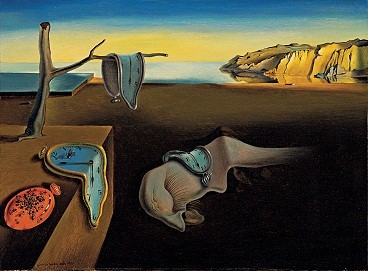
The term ”surrealism” was coined by the poet Guillaume Apollinaire when he wrote the program sheet to the ballet Parade in 1917. The ballet was a collaboration between Jean Cocteau, Eric Satie och Pablo Picasso (Doyle, 1998). Picasso made the costumes to this ballet. Another influential person for surrealism was André Breton, who wrote a surrealistic manifest in 1924 (Breton, 1964). Breton served in a neurological ward during World War I. There, he treated soldiers suffering from psychological trauma caused by the war. Breton became interested in hypnosis and Freud, and he developed a method for automatic writing.
Dali was born in Figueres in Catalonia, Spain, and he studied art in Madrid. Early in his career, Dali painted in a cubistic style, and in 1929 he joined a surrealistic group surrounding Breton. He joined Bretons group after his encounter with Mirò. Dali read Freud, and he became inspired by Freud (Gibson, 1997). Dali had also, as mentioned above, a great interest in science. In his antimatter manifest he wrote ”In the Surrealist period, I wanted to create the iconography of the interior world and the world of the marvelous, of my father Freud. Today, the exterior world and that of physics has transcended the one of psychology. My father today is Dr. Heisenberg.” (Dali, 1958).
Two famous examples where Dali was influenced by science are The Disintegration of the Persistence of Memory (figure 2) and The Madonna of Port Lligat (figure 3). Both are inspired by quantum physics. Due to the Pauli exclusion principle, one electron i permitted to occupy one state only. An electron can never exist between two quantum states, which makes the quantum world in a sense ”digital”. These two paintings are inspired by the ”digital” nature of quantum physics. Another example when Dali was inspired by science was his last painting The Swallow’s Tail (figure 4), that was inspired by catastrophe theory.
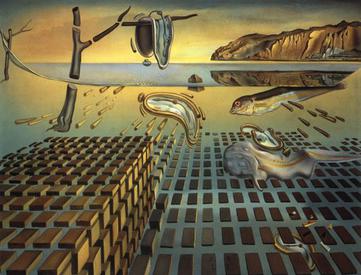
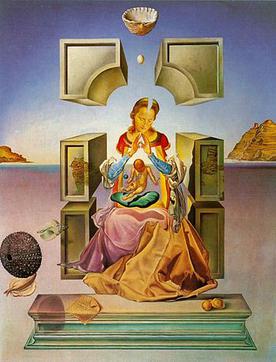
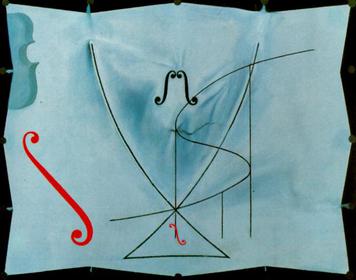
The art critic Dawn Adès (1982) hypothesised that the painting the persistence of memory was inspired by special relativity. Also, Gavin Parkinson (2008) proposed this theory in his book about surrealism and science. However, Dali himself was asked in person if this was his inspiration, and his answer was that, rather, it was a melting camembert that inspired this work (Marquès, 2004).
I chose this piece of art, since I, like Adès and Parkinson get an association with the theory of relativity. The theory of relativity is built on the idea that causal influences cannot travel faster than the speed of light. Also, the speed of light is the same for all observers. There is no preferred or absolute frame of reference, which implies that there is no absolute motion; all motion is measured relative to a specific reference frame. Another consequence is that a clock travelling in a high velocity relative to my reference frame, will be measured to tick slower compared to a clock in my own reference frame. Therefore, it is natural to associate “melting clocks” with the theory of relativity.
An open source software, starless (White, 2017), was used to simulate ray tracing through a black hole. The curved spacetime around a black hole can work as a gravitational lens. In the simulation, a clock is placed behind the black hole. Since the light rays are bent, the shape of the clock is distorted as shown in figure 5. The observant reader may note, that either the clock is unrealistically large, och the black hole is unrealistically small. But this is surrealism, so everything is permitted. I made the simulation as shown in figure 5 as a starting point for my paraphrase of Dalis painting the persistence of memory.

The finished paraphrase is shown in figure 6. The paraphrase I made here is an example of a kind of ”interaction” between art and physics. This can be tried by anyone. First, study some physics, and let those studies ”meld down” your former worldview. Then, a new worldview will replace the old worldview. In the next step, the process can be expressed through art. This process will be a kind of physics-art alchemy.
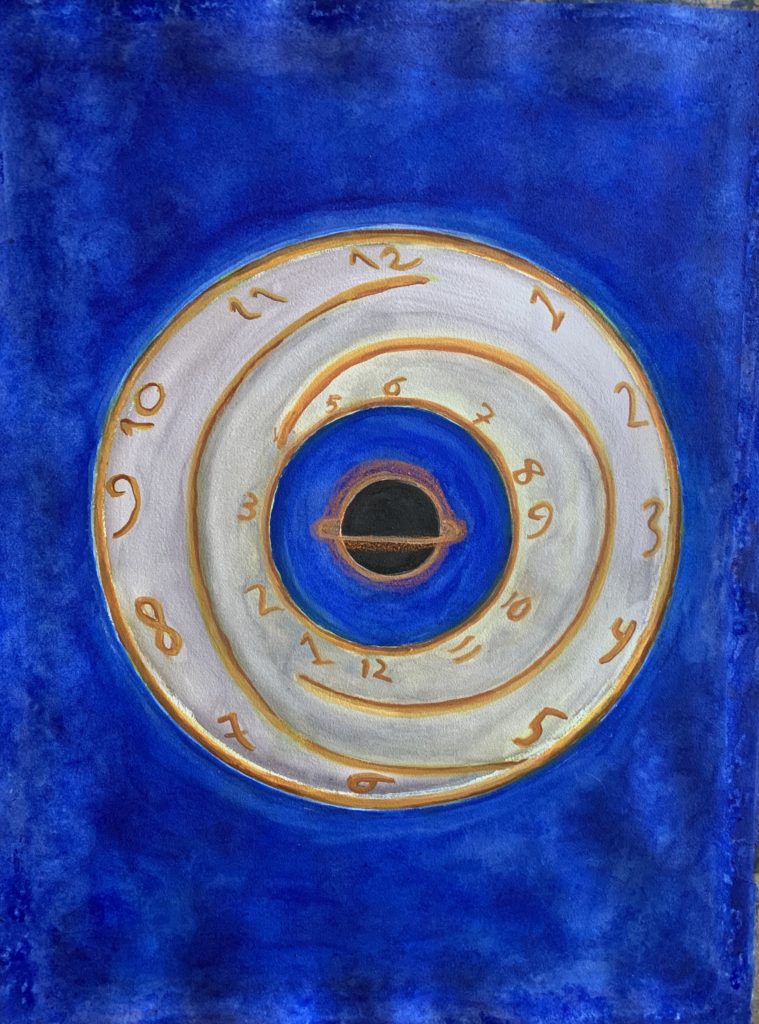
Referenser
Adès, D. (1982), Salvador Dalí, Thames and Hudson.
Breton, A. (1969). Manifestoes of Surrealism, University of Michigan Press.
Dali, S. (1958). Anti-matter manifesto, S. Dali. Catalogue.
Doyle, T. A. (1998). Erik Satie’s ballet Parade: an arrangement for woodwind quintet and percussion with Historical Summary, University of Massachusetts, Amherst, Louisiana State University
Gibson, I. (1997) The Shameful Life of Salvador Dalí, London, Faber and Faber.
Marquès, S. (Director) (2004). The Dali Dimension [Film], MVD Visual.
Parkinson, G. (2008), Surrealism, Art, and Modern Science: Relativity, Quantum Mechanics, Epistemology, Yale University Press.
White, W. (2017), Starless, https://github.com/rantonels/starless.